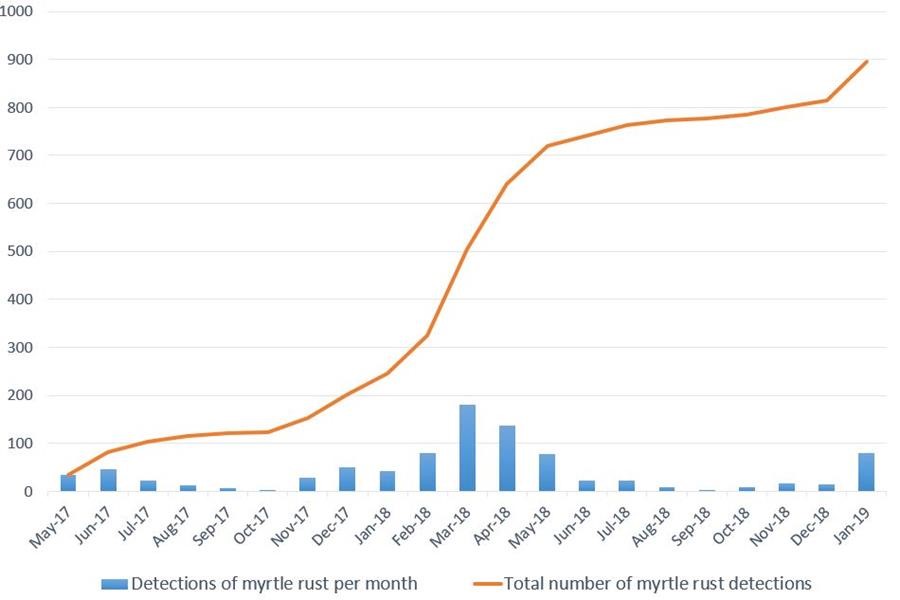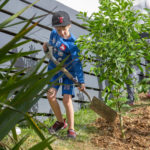Myrtle rust update
The following is an update provided by the Ministry for Primary Industries. Project Crimson is part of a collaborative steering group on myrtle rust.
Where myrtle rust has been found
895 infected properties have been reported since May 2017.
National detections of myrtle rust to date:
Northland – There are 36 sites/properties in Northland with confirmed infection. Most of these are in Kerikeri.
Taranaki – There are 283 sites/properties in Taranaki with confirmed infection. Most of these are in New Plymouth and Waitara.
Waikato – There are 106 sites/properties in the Waikato region with confirmed infection. Most of these are in Otorohanga and the Taupo district.
Bay Of Plenty – There are 174 sites/properties in the Bay of Plenty with confirmed infection. Most of these are in Te Puke and Bethlehem.
Auckland – There are 179 sites/properties in the Auckland region with confirmed infection. Most of these are in Remuera.
Wellington – There are 55 sites/properties in the Wellington region with confirmed infection. Most of these are in Lower Hutt and Upper Hutt
Manawatu-Whanganui – There are 25 sites/properties in the Manawatu region with confirmed infection. Most of these are in Fielding.
Tasman – There are 21 sites/properties in the Tasman region with confirmed infection. Most of these are in Collingwood, Patons Rock and Pohara.
Gisborne – There are 3 sites/properties in the Gisborne district with confirmed infection. These sites are all at the Northern tip of the East Cape.
Marlborough – There are 8 sites/properties in the Marlborough district with confirmed infection.
Nelson – There are 5 sites/properties in Nelson with confirmed infection.

Online training programme to help identify myrtle rust
Biosecurity New Zealand, in collaboration with the Department of Conservation has developed online training courses about myrtle rust. The courses are available to everyone but are particularly suited to those running community education events.
The online course covers:
• Background on myrtle rust in New Zealand
• Examples of myrtle rust and the myrtle family
• What to do if you find myrtle rust and how to dispose of infected plant material
• Myrtle rust research programme
• Myrtle rust seasonal variations
• Spread of myrtle rust
• Identifying the scale of impact of myrtle rust
The two modules take around 35 minutes each to complete.
Register to get access to the course
Check out one of the training videos below. Karin van der Walt, Conservation and Science Advisor at Otari Native Botanic Garden in Wellington shares examples of plants that can be affected by myrtle rust. All myrtle plants can be affected by myrtle rust including native New Zealand plants such as ramarama, pōhutukawa, rātā, mānuka, kānuka and tea tree and exotic plants including eucalysptus or gum trees, bottlebrushes, and willow myrtle.
Increase in myrtle rust finds during the summer and what to check for

There has been an increased level of positive myrtle rust detections during the summer months so far. The summer months provide ideal conditions for the spread of myrtle rust as infection risk is directly related to the duration of high relative humidity and temperature.
The Department of Conservation is extremely interested in any suspected myrtle rust on Public Conservation Land. So if you are spending time in our national parks and reserves over the summer please keep a special eye out for myrtle rust.
Basically the warmer and more humid it is, the better – like all fungi really. Therefore, late summer and autumn are likely to be the worst time for infection and spore risk.
Myrtle rust can look different in different stages during the progression of the disease. Be sure to look out for the following:

Bright yellow powdery eruptions appear on the underside of the young leaf

Bright yellow powdery eruptions of spores appear on both sides of the leaf

Overtime the pustules darken and become brown-grey

In case of severe infection, leaves may become twisted and die
If you think you see symptoms remember to not touch or collect samples, but take pictures and report it to Biosecurity New Zealand’s Exotic Pest and Disease Hotline on: 0800 80 99 66.
All plants in the myrtaceae family are susceptible to myrtle rust. For a list of myrtle plants in New Zealand you can visit the New Zealand Plant Conservation Network.
New evidence that myrtle rust can reproduce sexually
In January 2019, Biosecurity New Zealand found myrtle rust produced a teliospore stage in New Zealand. This spore stage indicates that the fungus is capable of reproducing sexually. The sample will be held at the New Zealand Fungarium managed by Manaaki Whenua Landcare Research.
Sexual reproduction introduces genetic variability, increasing the risk to New Zealand, as it allows fungi to adapt to new environments and possibly affect new hosts

Sexual and asexual pustules on M. communis.
It is not yet known how this disease will affect New Zealand species, but myrtle rust will likely continue to affect a wide range of susceptible myrtle plants. Overseas its impacts have varied widely from country to country and plant species to species.
 Give your plants the best chance against myrtle rust
Give your plants the best chance against myrtle rust
There is no confirmed way to stop myrtles from contracting the disease, but there are some ways that you can give myrtle plants in your garden the best chance against it.
Caring for your myrtle plants
It’s the new spring flush that is most susceptible to infection. To avoid stimulating new growth in warm weather it’s recommended that you avoid heavy pruning during warm weather if possible. Instead, prune myrtles only in late autumn and early winter. When pruning, use good hygiene practice, sterilise and disinfect tools and equipment with pure alcohol or methylated spirits to avoid transferring spores.
Reduce soil compaction and injury to tree roots
Reduce or avoid applying any herbicides around trees, trunk or root plate areas. Read the product label, as care is needed with some grass care products which can contain selective herbicides that impact on garden plants and their growth patterns. Avoid lawn care or weed control products around the dripline of a tree. Tree roots do not like soil compaction and this can reduce tree health by stopping water absorbing into the soil, reducing oxygen in the soil as well as physically damaging the roots of trees which can allow the entry of diseases. Consider selecting low clumping or bulb type plant varieties if planting under established trees.
Use Mulch
The use of wood chip mulch could help improve the soil around trees as it helps plant establishment and growth. It helps keep water in the soil, keeps soil cooler, and produces a better habitat for soil microorganisms. Wood mulch may be available for free from arboriculture companies. Keep mulch away from the stem or trunk, but you can pile it up to 20cm deep. Replenish mulch as it breaks down (faster in some seasons than others). Homemade compost is also a good top-dressing for around trees and plants.
Apply Fertiliser
Only use fertiliser on garden or plantation trees. Wild natural trees or stands of vegetation should not be fertilised. Natural products such as fish meal, blood and bone or sheep pellets will support soil microorganisms as well as the plants. Seaweed based fertilisers can also be used, and the use of products with humic acid, and trace minerals can help with soil health and root development. Products with phosphorous and potassium can help with root and shoot development.
Find out more about specific groups of myrtle rust

Help limit the spread of myrtle rust in your area
Here’s a few handy tips that will help reduce the risk of spreading myrtle rust in your area.
Arrive clean, leave clean
The forest you visit could be infected with myrtle rust without you knowing it. Before entering such areas for work or recreation, you should minimise the risk of spreading the rust by ensuring your equipment, clothing and tools arrives clean and leaves the area clean.
Buy healthy plants
Make sure myrtle plants bought for your garden are free from the symptoms of myrtle rust. Inspect the leaves and stems of plants before you buy them, and avoid purchasing plants that have signs of disease.
Monitor your plants
Regular monitoring of myrtle plants will alert you to signs of myrtle rust, particularly new, young growth, shoots and seedlings. Early detection in your garden will give you time to consider options for myrtle rust control on your property. If myrtle rust does establish on your property, note which plants become the most severely affected. Keep an eye out for myrtle rust in any parks and reserves you visit.

Resources for landowners
If you own or manage land with plants that are infected with myrtle rust, you can either:
• care for the plants and monitor the impact of the disease
• remove or prune the infected plants and securely dispose of the waste
If you’re transporting and disposing of infected plant material, you must comply with the general permission conditions issued by the Ministry for Primary Industries (MPI).
If you choose to remove or prune infected plants, you may require specialist equipment and technical skills. We recommend you consider hiring an arborist or contractor to remove infected plants on your property, especially if you have large trees.
A step-by-step guide is also available to help you.
For more information on managing myrtle rust on your property go to Biosecurity New Zealand’s myrtle rust webpage.
More information and resources
- Managing myrtle rust on your property
- How to remove infected myrtle plants
- Biosecurity New Zealand’s myrtle rust home page
- Department of Conservation’s myrtle rust page
- Myrtle rust research programme
- Myrtle rust fact sheet
- Read more about myrtle rust
- The New Zealand Plant Conservation Network
- Definition of the myrtle genus from Encylcopedia Britannica
- Landcare Research Plant Identification and Interactive Keys
- iNaturalist is a place where you can share what you see in nature, set up citizen science and community-based monitoring projects, meet other nature watchers, and learn about New Zealand’s natural history
- Radio New Zealand’s ‘Our Changing World’ podcast on myrtle rust research




